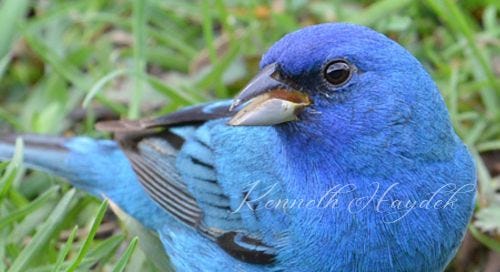April: The Indigo Bunting
Reminiscent of the color of the sky at twilight, male indigo buntings are a common springtime delight in the southern and eastern United States.
The vivid blues and purples of breeding male indigo buntings are due to a magnificent optical quality, rather than any pigment in their feathers. The feathers themselves reflect and refract blue light, giving them the dreamish sky color they are known for. In low light, male indigo buntings appear dark, with only their (pigmented) brown feathers apparent.
Female indigo buntings, immature males, and males outside of breeding season are much less spectacular—mostly brown, with white throats. Females may have blue tinge on their wings, tail, or rump, while immature males may have patchy blues intermixed with their brown feathers.
Indigo buntings are small birds, barely five inches tall, with short, cone-shaped silver bills, short tails, and overall plumpish appearance. Their small stature helps distinguish them from other blue bird species, especially bluebirds and blue grosbeaks, both of which are larger.
Indigo buntings live in shrubby, brushy, and bushy areas often off roadsides, weed fields, and woodland edges. Female indigo buntings build nests alone in low shrubs one to three feet from the ground, weaving together bark, grasses, and stems into a small cup, which is then covered with spider webs and lined with thistle down. Indigo buntings have on average two broods a year, sometimes three, mostly cared for by females.
While the females are more hidden during breeding season, male indigo buntings like to perch on high places and sing. Nicknamed “blue canaries,” their persistent, springy whistle song is well-known in areas where they are populous. They sing song phrases in duplicate, creating a pattern that becomes recognizable. Young male birds learn their songs from older males in the area; variations in indigo bunting songs are peculiar to “neighborhoods,” where local songs may be carried on for a couple of decades before the tune begins to evolve.
Indigo buntings feed on small seeds, like thistle and nyjer seeds, and berries; during breeding season, they also eat insects for extra protein. It is thought that indigo buntings may be something of a boon to farmers, cleaning off weed seeds and pest insects.
Indigo buntings are migrants, spending their winters in the Caribbean and Central America and their summers in much of the United States east of the Mississippi River. Like many birds, they migrate by night. Indigo buntings navigate their way using the stars for guidance. They have a sort of internal compass to adjust their orientation to a particular star, even as it moves across the night sky. Indigo buntings were instrumental in helping scientists understand the nocturnal migration of birds. In the 1960s, scientists used indigo buntings in a planetarium experiment to understand how birds use stars to migrate at night.
While indigo buntings may be difficult to spot during their nighttime flights, you may have much more success finding them by listening for their energetic song during daytime hours, especially early in the morning, when male indigo buntings are known to sing as many as 200 hundred songs per hour. Talk about starting your day on the upbeat!
Sources:
https://www.allaboutbirds.org/guide/Indigo_Bunting/
https://www.audubon.org/field-guide/bird/indigo-bunting
https://abcbirds.org/bird/indigo-bunting/
https://mdc.mo.gov/discover-nature/field-guide/indigo-bunting
https://ebird.org/species/indbun
https://www.allaboutbirds.org/guide/Indigo_Bunting/sounds



